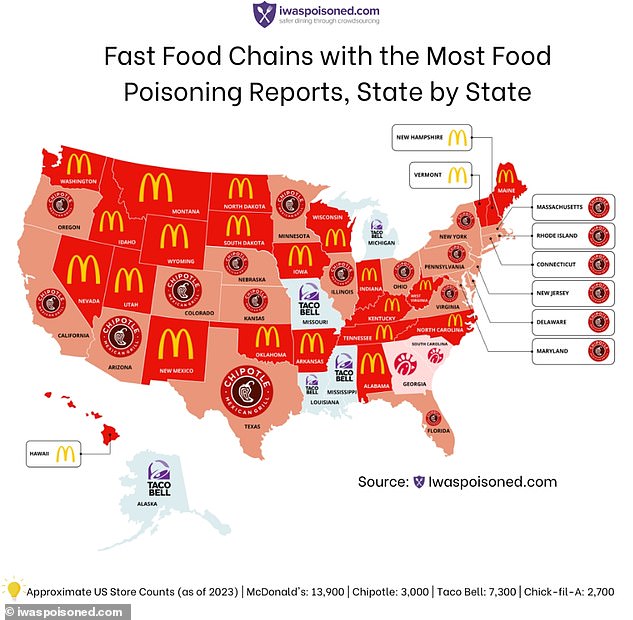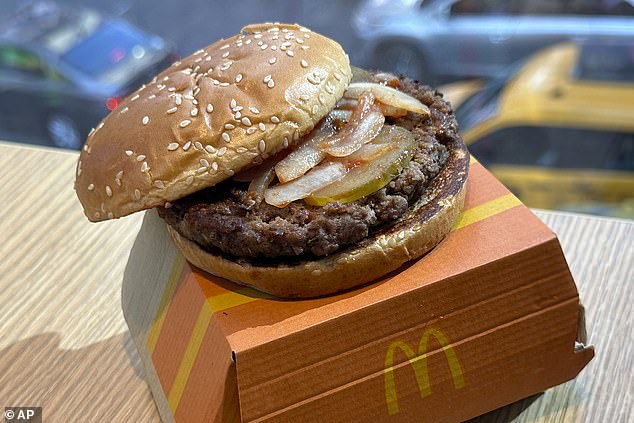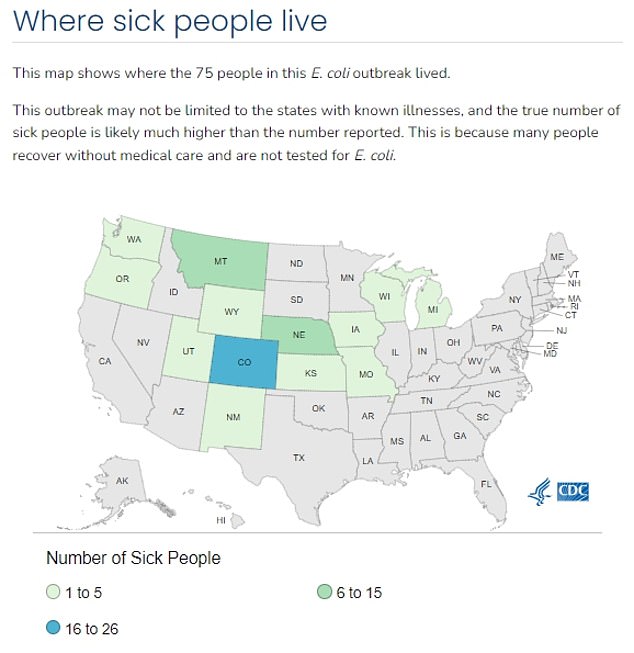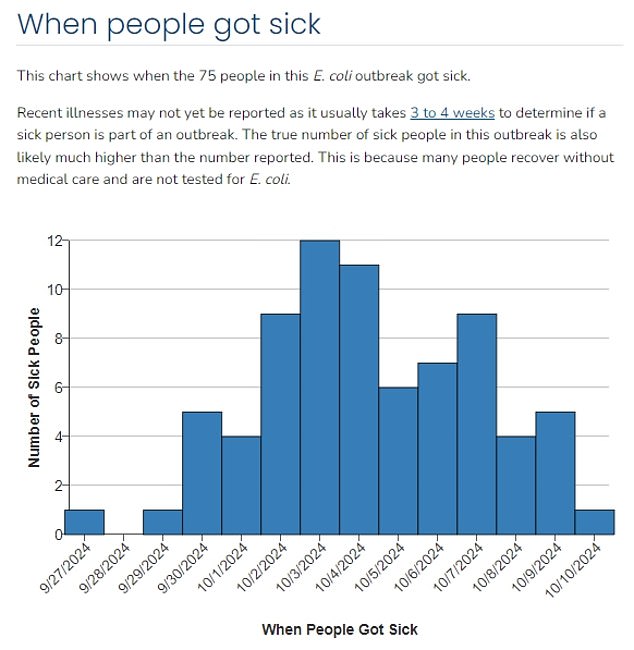Fast food chains most likely to make you sick in every state – amid McDonald’s E Coli outbreak
An E Coli outbreak caused by McDonald’s Quarter Pounders has sparked new fears about the safety of fast food.
But according to a new report, it’s not burgers Americans need to worry about, but rather salads.
Sweetgreen, a Los Angeles-based salad company on a mission to change fast food, was the biggest cause of illness among major brands, the report said.
Diners who ate there were 10 times more likely to become ill from food poisoning or stomach upset than the average at other restaurants.
Applebee’s came in second, with guests 150 percent more likely to get sick than average, and McDonald’s came in third, with 60 percent more customers overall.
For the report, researchers tracked illness reports from 70,000 restaurants over the course of the year 2023 to calculate an average per 100 restaurants. They then compared this with the number of illness reports per 100 restaurants per chain for the same year.
It comes next McDonald’s was forced to pull the Quarter Pounder from a fifth of its restaurants last Tuesday after a CDC investigation linked the onions to an E Coli outbreak that has sickened 75 people and killed one.
Days later, Burger King, KFC, Taco Bell and Pizza Hut also removed onions from their stores as a ‘proactive’ measure.
McDonald’s has re-added the Quarter pounder to its menus and the outbreak appears to be slowing.
The above, published this year, is the estimate from iwaspoisoned.com’s report on the likelihood of major brands getting sick each year (black dotted line)

The above map claims to show the top restaurant in terms of food problem reports by state from 2012 to 2023. The map is based on unverified reports and calculated based on the total number of reports.
But as concerns about food safety increase, report by iwaspoisoned.comhighlights restaurants that are more likely to make you sick than others.
The quick salad company had a food poisoning rate eleven times higher than the site’s benchmark, which represented an industry average based on locations, complaints and revenue.
To calculate the rates, the website established a ‘benchmark’ for food poisoning represents industry averages for 108,000 food poisoning reports from 70,000 restaurant locations in the US.
The rates take into account and are corrected for turnover, the number of branches a company has and the number of food poisoning complaints a chain has.
These measurements ensuring a fairer comparison of a brand’s performance against industry averages.
Based on these methods, iwaspoisoned.com determined that Sweetgreen was by far the worst offender, with an eleven times higher risk of food poisoning.
The reason why Sweetgreen topped the list was unclear, but experts suggested it may be due to the fact that the chain’s fresh produce was not heated before being served – a practice that reduces the chance of eliminating harmful bacteria.
With positive results, Dairy Queen, Subway and Pizza Hut had all reduced the risk of food poisoning compared to the industry benchmark.
The website, iwaspoisoned.comcollects complaints about stomach upsets and food poisonings from consumers, as well as the names of the restaurants they believe caused their illness.
The claims have not been officially verified and anyone can report an illness – but the website says they could be a good harbinger of an emerging outbreak.
Mitzi Baum, the chief executive of Stop Foodborne Illness – which campaigns for safer food – said the site was “interesting” and “has been useful in identifying potential cluster diseases and larger outbreaks”.
Restaurant chains criticize the team, saying it is unreliable because it allows anonymous and unverified submissions – which they say can lead to false reporting.
Some public health officials have also objected, saying victims are not always able to correctly identify what made them sick.

Clarissa DeBrock, a 33-year-old mother of one from Nebraska, is suing McDonald’s because she believes their Quarter Pounders caused her illness

The onions from the burgers (pictured) have been at the center of an investigation into an E.coli outbreak that has so far affected 49 people, hospitalized ten and killed one
In a separate one report last year, iwaspoisoned.com collected and compared the number of food poisoning complaints related to fast food establishments in each state.
For this report, the website used the raw number of complaints from fast food companies. It did not calculate rates based on food poisoning complaints regarding the number of restaurants in each state.
McDonald’s had the most complaints in 23 of the 50 US states – or 46 percent.
Chipotle came in second and was the most complained about fast food chain in twenty states.
Taco Bell came in third and caused the most illnesses in five states, and Chick-Fil-A came in fourth and topped the list in two states.
The analysis included 13,900 McDonald’s stores; 7,300 Taco Bell restaurants; 3,000 chipotles; and 2,700 Chick-fil-As.
Anyone can submit a report online, which is then checked by moderators to make sure it’s not a joke or spam. Most are included in the website figures.
The system did not detect McDonald’s latest outbreak, although the website’s founder, Patrick Quade, told DailyMail.com that they were “consistently” receiving complaints about the company – an average of about 500 per month.
One complaint they received during the outbreak was from an individual and their son in Utah, with both saying they became sick after eating a Quarter Pounder.
Submitted on October 2, it read: ‘Within a few days [of eating at McDonald’s]. I started throwing up everything (including water) several times a day and getting chills with a low-grade fever. My symptoms lasted about two weeks.
‘My son also got sick, but didn’t throw up. He did have diarrhea for a few days and went to an InstaCare when it became bloody.’

The above map shows the states where illnesses linked to the recent E. coli outbreak have been reported

The above shows a timeline of when people reported being sick, according to the patients
Clarissa DeBrock, who says she got sick after eating at McDonald’s, is among those to reveal she is suing the fast food giant.
The 33-year-old said she consumed a Quarter Pounder last month while dining at her local McDonald’s in North Platte, Nebraska, with her fiancé and two-year-old son.
The burger looked and tasted normal, but five days later she started experiencing stomach cramps, diarrhea and nausea. Her symptoms became so severe that she was admitted to the emergency room on September 25.
She tested positive for the same E.coli strain behind the McDonald’s outbreak and believes food from the restaurant caused her illness.
On Sunday, McDonald’s revealed that tests had shown that its Quarter Pounder beef patties were not behind the outbreak.
The company said dozens of tests were conducted on patty subsamples in Colorado, all of which were negative.
They also said on Sunday that the Quarter Pounder would now return to the restaurants it was withdrawn from – although it would no longer feature onions at 900 locations as they continue to look for a second supplier.
Vineet Dubey, an attorney and partner at Custodio and Dubey LLP in Los Angeles, described the outbreak that has hit McDonald’s as “very serious.”
“Many people get sick from E.coli diarrhea for a few days before they get better,” he said.
‘But if the food poisoning is so bad that someone ends up in hospital, action can be taken from a legal perspective.’
